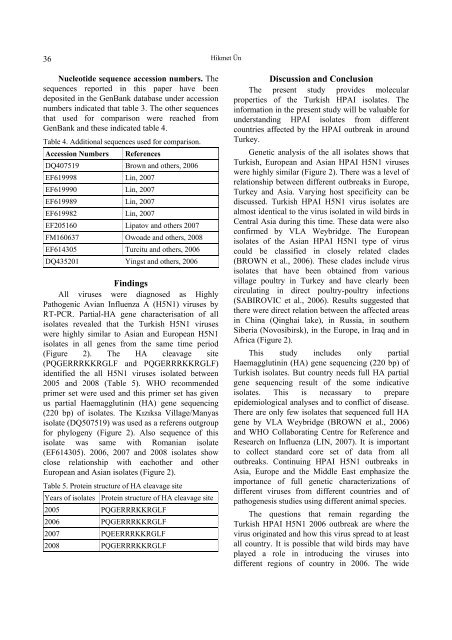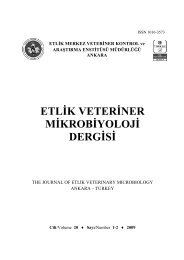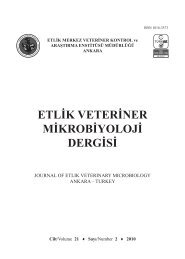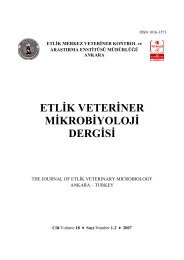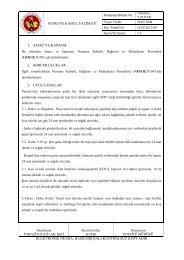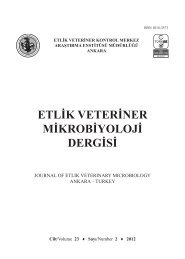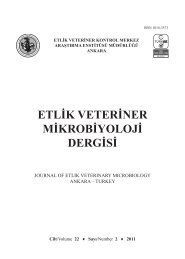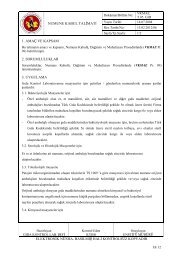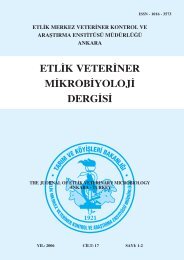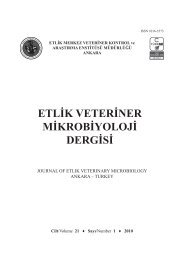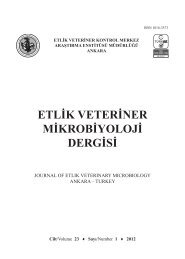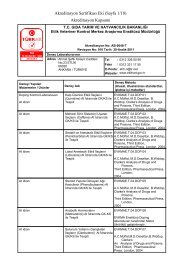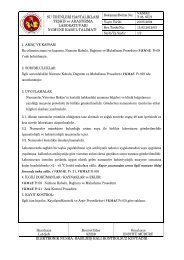Cilt/Volume 19 Sayı/Number 1-2 2008 - veteriner kontrol merkez ...
Cilt/Volume 19 Sayı/Number 1-2 2008 - veteriner kontrol merkez ...
Cilt/Volume 19 Sayı/Number 1-2 2008 - veteriner kontrol merkez ...
You also want an ePaper? Increase the reach of your titles
YUMPU automatically turns print PDFs into web optimized ePapers that Google loves.
36<br />
Nucleotide sequence accession numbers. The<br />
sequences reported in this paper have been<br />
deposited in the GenBank database under accession<br />
numbers indicated that table 3. The other sequences<br />
that used for comparison were reached from<br />
GenBank and these indicated table 4.<br />
Table 4. Additional sequences used for comparison.<br />
Accession <strong>Number</strong>s References<br />
DQ4075<strong>19</strong> Brown and others, 2006<br />
EF6<strong>19</strong>998 Lin, 2007<br />
EF6<strong>19</strong>990 Lin, 2007<br />
EF6<strong>19</strong>989 Lin, 2007<br />
EF6<strong>19</strong>982 Lin, 2007<br />
EF205160 Lipatov and others 2007<br />
FM160637 Owoade and others, <strong>2008</strong><br />
EF614305 Turcitu and others, 2006<br />
DQ435201 Yingst and others, 2006<br />
Findings<br />
All viruses were diagnosed as Highly<br />
Pathogenic Avian Influenza A (H5N1) viruses by<br />
RT-PCR. Partial-HA gene characterisation of all<br />
isolates revealed that the Turkish H5N1 viruses<br />
were highly similar to Asian and European H5N1<br />
isolates in all genes from the same time period<br />
(Figure 2). The HA cleavage site<br />
(PQGERRRKKRGLF and PQGERRRKKRGLF)<br />
identified the all H5N1 viruses isolated between<br />
2005 and <strong>2008</strong> (Table 5). WHO recommended<br />
primer set were used and this primer set has given<br />
us partial Haemagglutinin (HA) gene sequencing<br />
(220 bp) of isolates. The Kızıksa Village/Manyas<br />
isolate (DQ5075<strong>19</strong>) was used as a referens outgroup<br />
for phylogeny (Figure 2). Also sequence of this<br />
isolate was same with Romanian isolate<br />
(EF614305). 2006, 2007 and <strong>2008</strong> isolates show<br />
close relationship with eachother and other<br />
European and Asian isolates (Figure 2).<br />
Table 5. Protein structure of HA cleavage site<br />
Years of isolates Protein structure of HA cleavage site<br />
2005 PQGERRRKKRGLF<br />
2006 PQGERRRKKRGLF<br />
2007 PQEERRRKKRGLF<br />
<strong>2008</strong> PQGERRRKKRGLF<br />
Hikmet Ün<br />
Discussion and Conclusion<br />
The present study provides molecular<br />
properties of the Turkish HPAI isolates. The<br />
information in the present study will be valuable for<br />
understanding HPAI isolates from different<br />
countries affected by the HPAI outbreak in around<br />
Turkey.<br />
Genetic analysis of the all isolates shows that<br />
Turkish, European and Asian HPAI H5N1 viruses<br />
were highly similar (Figure 2). There was a level of<br />
relationship between different outbreaks in Europe,<br />
Turkey and Asia. Varying host specificity can be<br />
discussed. Turkish HPAI H5N1 virus isolates are<br />
almost identical to the virus isolated in wild birds in<br />
Central Asia during this time. These data were also<br />
confirmed by VLA Weybridge. The European<br />
isolates of the Asian HPAI H5N1 type of virus<br />
could be classified in closely related clades<br />
(BROWN et al., 2006). These clades include virus<br />
isolates that have been obtained from various<br />
village poultry in Turkey and have clearly been<br />
circulating in direct poultry-poultry infections<br />
(SABIROVIC et al., 2006). Results suggested that<br />
there were direct relation between the affected areas<br />
in China (Qinghai lake), in Russia, in southern<br />
Siberia (Novosibirsk), in the Europe, in Iraq and in<br />
Africa (Figure 2).<br />
This study includes only partial<br />
Haemagglutinin (HA) gene sequencing (220 bp) of<br />
Turkish isolates. But country needs full HA partial<br />
gene sequencing result of the some indicative<br />
isolates. This is necassary to prepare<br />
epidemiological analyses and to conflict of disease.<br />
There are only few isolates that sequenced full HA<br />
gene by VLA Weybridge (BROWN et al., 2006)<br />
and WHO Collaborating Centre for Reference and<br />
Research on Influenza (LIN, 2007). It is important<br />
to collect standard core set of data from all<br />
outbreaks. Continuing HPAI H5N1 outbreaks in<br />
Asia, Europe and the Middle East emphasize the<br />
importance of full genetic characterizations of<br />
different viruses from different countries and of<br />
pathogenesis studies using different animal species.<br />
The questions that remain regarding the<br />
Turkish HPAI H5N1 2006 outbreak are where the<br />
virus originated and how this virus spread to at least<br />
all country. It is possible that wild birds may have<br />
played a role in introducing the viruses into<br />
different regions of country in 2006. The wide


